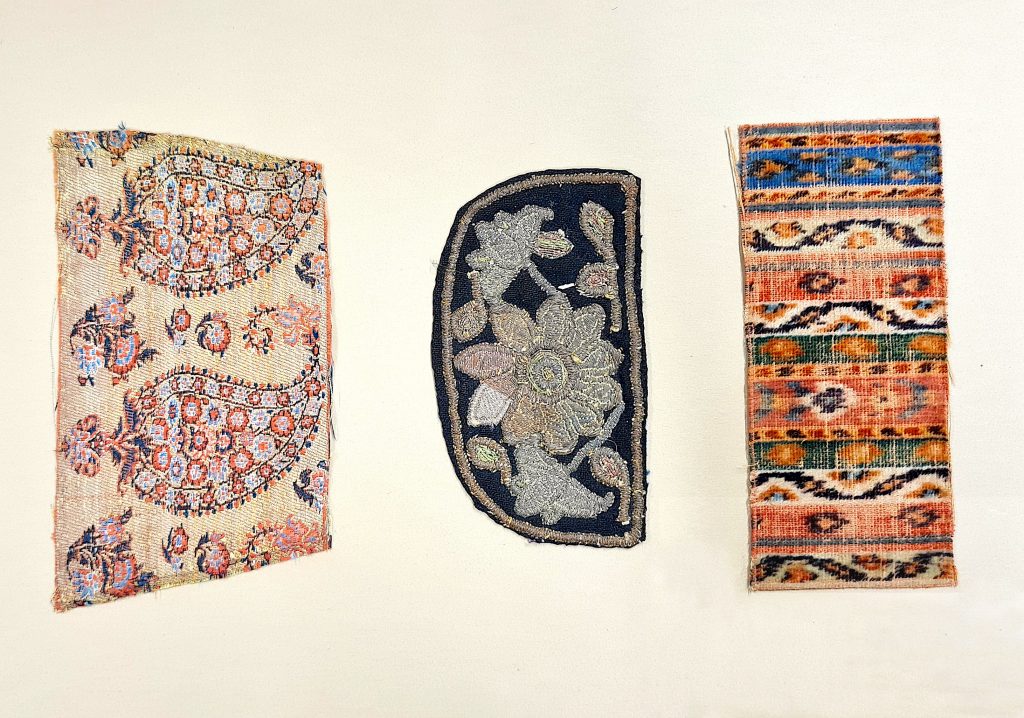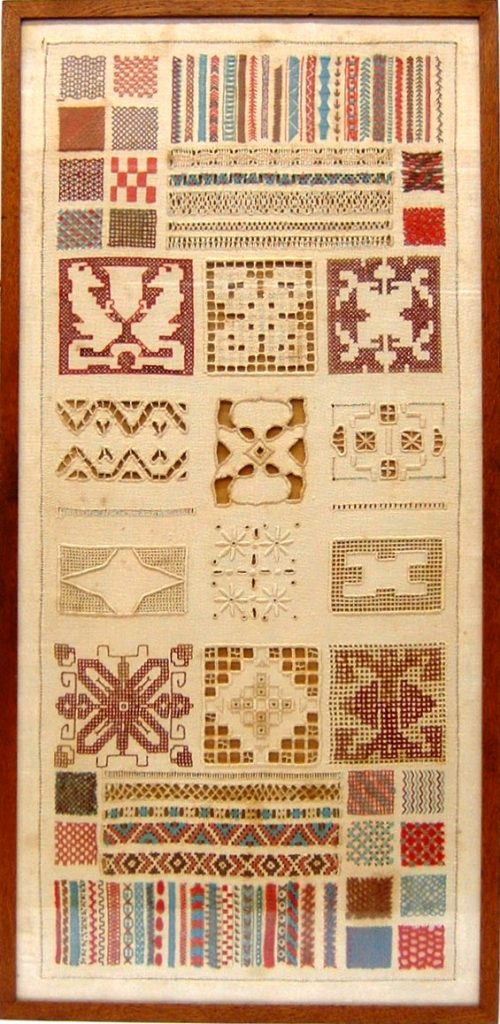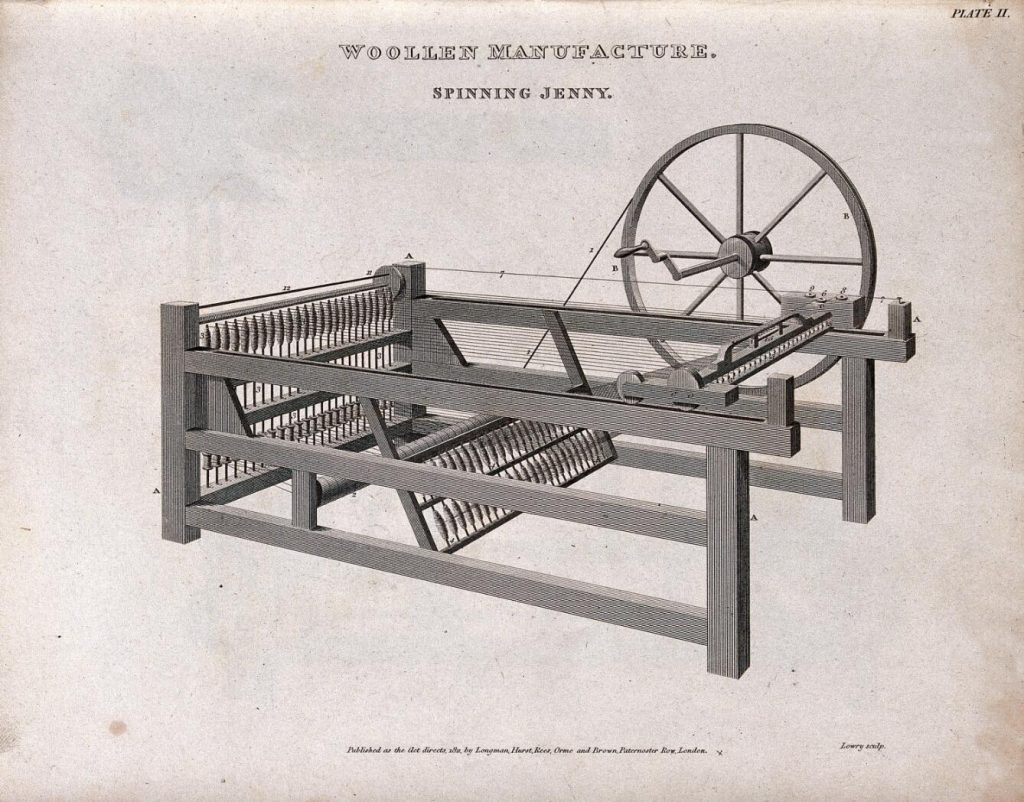A recent survey of heritage artefacts at UC has thrown up an interesting variety of unusual teaching tools employed by Canterbury staff and students over the last 150 years. Recent UC History graduate Alethea Chai has a passion for the history of textiles and fashion, and was inspired to delve further into the history behind a very special collection of fabric samples in the care of by the Department of Art History. The samples traverse history from seventeenth-century Persia (where the oldest samples originate), to twentieth century America, and on to the present day in Ōtautahi Christchurch.
The University of Canterbury is the second oldest university (after Otago) in New Zealand, and with the University’s 150th anniversary rapidly approaching in 2023, it’s a good time to reflect on our history. Sitting in various storerooms on the Ilam campus are relics of the Canterbury College period of the University’s history (1873 to ca. 1960), and included amongst them is a fascinating collection of 35 fabric samples housed by the Department of Art History and Theory, which testify to the tactile teaching methods required by the pre-internet lecture hall.

It is not yet known exactly how the collection of fabric samples, which run from seventeenth-century silks to Samoan tapa cloths, was acquired by Canterbury College. However, research for this article has established that the fabric samples were originally part of a larger collection assembled by sisters Eliza M. and Sarah L. Niblack.[1] Eliza Niblack was a textile curator, and her brother, Admiral Albert P. Niblack, collected textiles on her behalf while stationed overseas in the early twentieth century.[2] In a review of a recent exhibition of textiles from the collection, Christine Tate noted that the collection benefitted from “[t]he Admiral’s untrained but apparently unfailing eye and his noted anthropological interest in autochthonous peoples.”[3]
Admiral Niblack died in 1929 and left his sisters, Eliza and Sarah, his collection. When they then passed away in 1930 and 1933 respectively, their collections were subsequently donated to the John Herron Art Institute (now the Indianapolis Museum of Art).[4] Canterbury College may perhaps have acquired the fabric samples from the Indianapolis Museum of Art in the 1930s, when they were deaccessioning some of the samples. Alternatively, the College may have acquired them directly from Eliza’s sister Sarah in the 1920s. It is recorded that Sarah Niblack sold a nineteenth-century Moroccan valance to the Metropolitan Museum of Art in 1923, so Canterbury College may have similarly been recipients of textiles direct from the Niblack family.

Why would Canterbury College have acquired a collection of historic fabrics? One theory is that these fabric samples were used for teaching and research at Canterbury College. Contained within a specially made box and matted like miniature artworks, the fabric samples would certainly have been useful tools for art history classes or textile design classes. The Canterbury College School of Art offered a broad range of subjects in the early twentieth century.[5] Pre-war subjects included dressmaking, millinery and embroidery. The 1921 Prospectus, for example, lists ‘History of Ornament’ as a component of both the ‘Art Needlework’ and ‘Millinery and Dressmaking’ courses.
After the Second World War, textiles were still included in the Fine Arts curriculum. In 1946 a course in ‘Weaving and Tapestry’ was introduced, and according to the 1949 Prospectus, the ‘Needlecraft’ course covered subjects such as historic and peasant embroideries as well as plain and tapestry weaving. This course would be a likely candidate for the use of the fabric samples. They could have been used as examples for the students to examine and learn from as they produced their own work. See, for example, the embroidery sampler made by Audrey Black at the School of Art in the 1940s. Another candidate for the use of the fabric samples would have been Art History classes. ‘History of Art’, according to the 1921 Prospectus, was in the courses offered ‘For Girls’ as well as ‘For Boys’. In a course such as this, perhaps the textiles were used to assist with dating portraits, or to glean information about people’s social class and identity in historical paintings.

Whether or not the samples were originally used as teaching tools for art history and textile design, the collection is a fascinating resource for considering the history of textiles and fashion. For instance, most of the fabric samples are handwoven, hinting strongly at the craftsmanship required to create textiles. Spinning and weaving are some of the oldest crafts in human history, and can be found in sources since antiquity – a famous example is Penelope in Homer’s epic poem The Odyssey.
The more recent fabric samples in the collection, such as the Scotch Paisley or the eighteenth-century European tapestry weave, also testify to changes in manufacturing technologies. In the late eighteenth and nineteenth centuries the Industrial Revolution saw advances in textile-making technologies. The Spinning Jenny, a machine that could spin raw fibres, was an important innovation of the time. Previously, fibres were spun by hand using spinning wheels (à la Sleeping Beauty). As the new textile-making technologies were less labour intensive, traditional craftsmen were put out of work. This led to the Luddite Riots, a series of protests by a group of British craftsmen whose livelihoods were affected by these innovations. Beginning in 1811, these workers destroyed machinery such as power looms.[6] The modern term ‘luddite’, referring to someone technically challenged or opposed to new technology, has its roots in a critical time in textile history.

Another interesting feature of historical handwoven fabrics is that they are often more tightly woven, and are therefore longer lasting than modern twenty-first century fabrics made on a power loom. This helps to explain in part why the fabric samples at UC, including the silks and velvet weave, are in such good condition. Many extant historic dresses have unfinished seams that show little fraying. On modern garments, which are also subject to the rigours of washing machines, unfinished seams fray rapidly due to the lower quality of many fabrics. Historic fabrics also were much more breathable to wear as they were made of natural fibres such as linen, silk, cotton and wool. Comparatively, many modern garments are made of polyester or plastic, which do not breathe. Many of the fabric samples in UC’s collection attest to a time when textiles were the product of craftsmanship – a time of ‘slow fashion’ alien to our modern fast fashion textile industry.
Finally, these textiles can also speak to significant moments of cultural history. For example, the samples of eighteenth-century French and Russian block printed cotton attest to a craze for chintz (printed cotton) when it became a hot commodity in eighteenth and early nineteenth-century Europe. Chintz designs were often inspired by the taste for Chinoiserie (‘exotic’ or ‘oriental’ products in Europe that arose from trade with China and the East).[7] French Queen Marie Antoinette was famously criticised for wearing cotton as it hurt the French silk industry, but she helped to ignite the craze across Europe and the profits of this trend ended up in the pockets of England, who exploited Indian textile makers.[8] As demand rose, Europe looked to slave-produced cotton from America. Despite the exploitative production methods, cotton, especially chintz, was not seen as a cheap textile but rather as a status symbol. However, the reality of the cotton industry was not nearly as pretty as the finished garments. Sadly, the practice of exploiting textile workers continues today. According to the BBC, Indian textile workers are still reportedly exploited by luxury European brands.[9]

This small collection of fabric samples at UC have historical significance on several levels then. As examples of teaching methods in twentieth-century New Zealand, they emphasise the early history of the Canterbury College Arts programmes, even if their exact use is unknown. They are reminders of the role textiles and related crafts had in the School of Art and in women’s education in the early years of the University. Furthermore, the fabric samples testify to the history of textile production. They represent a diverse range of textile-making techniques and are the product of historical craftsmanship. Individual samples also represent particular moments in cultural history, such as the craze for eighteenth-century chintz. Hopefully by bringing them to the light again, these historical textile samples can be informative to a new generation.
Alethea Chai recently graduated from Canterbury with a Masters in History with Distinction. Her dissertation, “Dressing for success in medieval France: the function of fashion in Christine de Pizan’s oeuvre”, explores the uses of fashion in the life and works of Europe’s first feminist. She is now working for the Department of Internal Affairs in Wellington as a content writer. In her free time she researches and reconstructs historical costumes, and has won both Best in Show at Christchurch Armageddon 2021 and Judge’s Choice at the CNZ Masquerade Ball 2022 costume contests.
Acknowledgements:
Our thanks especially to the Department of Art History and Theory for access to their resource collection, and to Erin Kimber at Macmillan Brown Library for research support for this article. All images are copyright to UC unless otherwise stated.
Footnotes:
[1] Collection not to be confused with the Admiral Albert P. Niblack Collection (admiral-albert-p-niblack-collection-1843-1929.pdf).
[2] “Moroccan Mastery with Textiles,” The Washington Times , July 18, 2013, https://www.washingtontimes.com/news/2003/jul/18/20030718-082637-2428r/.
[3] Christine Tate, “The Fabric of Moroccan Life,” Textile 3, no. 2 (2005): 192, DOI: 10.2752/147597505778052558.
Andrea Nicol (curator), “The Fabric of Moroccan Life” (National Museum of African Art), accessed August 16, 2022, https://africa.si.edu/exhibits/fabric/index.html.
[4] “Herron Art Notes,” The Indianapolis Times, October 9, 1924, Home edition, Chronicling America: Historic American Newspapers, Library of Congress, https://chroniclingamerica.loc.gov/lccn/sn82015313/1924-10-17/ed-1/seq-9/.
[5] To learn more, you can check out the online exhibition, Art School 125: 125 Years of the School of Fine Arts at the University of Canterbury.
[6] “Luddite,” in A Dictionary of World History, Oxford University Press (2015) https://www.oxfordreference.com/view/10.1093/acref/9780199685691.001.0001/acref-9780199685691-e-2216.
[7] Eilunud Edwards, “Lasting impressions: Indian block-prints and global trade,” Textile Symposium of America Symposium Proceedings (2016): 98-100
[8] Jason Hickel, “How Britain Stole $45 Trillion from India,” Al Jazeera, December 19, 2018, https://www.aljazeera.com/opinions/2018/12/19/how-britain-stole-45-trillion-from-india.
[9] Rajini Vaidyanathan, “Indian factory workers supplying major brands allege routine exploitation,” BBC, 17 November, 2020, https://www.bbc.com/news/world-asia-54960346.
Bibliography:
Edwards, Eilunud. “Lasting impressions: Indian block-prints and global trade.” Textile Symposium of America Symposium Proceedings (2016): 97-107.
“Herron Art Notes.” The Indianapolis Times, October 9, 1924, Home edition. Chronicling America: Historic American Newspapers. Library of Congress. https://chroniclingamerica.loc.gov/lccn/sn82015313/1924-10-17/ed-1/seq-9/.
Hickel, Jason. “How Britain stole $45 trillion from India,” Al Jazeera, 19 December, 2018. https://www.aljazeera.com/opinions/2018/12/19/how-britain-stole-45-trillion-from-india.
“Luddite.” In A Dictionary of World History. Oxford University Press (2015) https://www.oxfordreference.com/view/10.1093/acref/9780199685691.001.0001/acref-9780199685691-e-2216.
“Moroccan Mastery with Textiles.” The Washington Times , July 18, 2013. https://www.washingtontimes.com/news/2003/jul/18/20030718-082637-2428r/.
Nicol, Andrea (curator). “The Fabric of Moroccan Life.” National Museum of African Art. Accessed August 16, 2022. https://africa.si.edu/exhibits/fabric/index.html.
Tate, Christine. “The Fabric of Moroccan Life.” Textile 3, no. 2 (2005): 190-93. DOI: 10.2752/147597505778052558.
Vaidyanathan, Rajini. “Indian factory workers supplying major brands allege routine exploitation.” BBC, 17 November, 2020. https://www.bbc.com/news/world-asia-54960346.
A brilliant article and an amazing treasure – very enlightening and educational on many Levels of time. Congratulations Alethea Chai a talented historian.